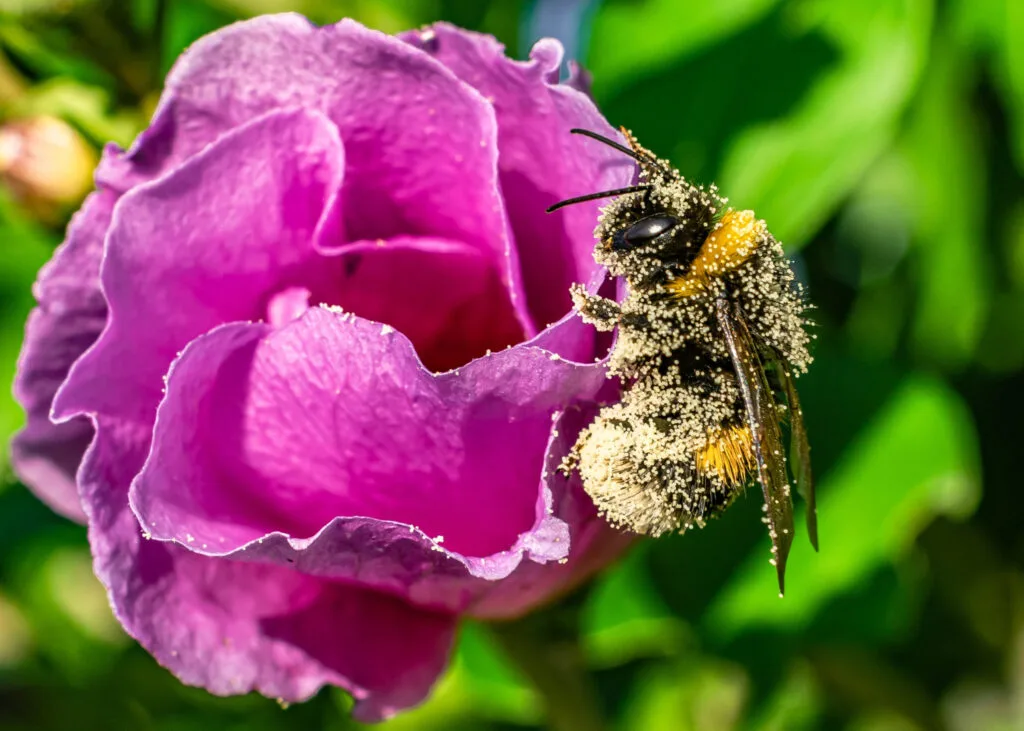Introduction
You can spot a mason bee by its sturdy, medium build and shiny colours that range from metallic green and blue to black. Unlike honeybees, they carry pollen on their bellies instead of their back legs. Mason bees usually live alone, making their homes in small holes or cracks, which they neatly seal with mud. Males often have a little white tuft on their faces, while females are bigger and usually have a black or metallic body with a matching abdomen.
The Mason Bee (Osmia) is a small, hard-working solitary bee known for its exceptional pollination skills. Unlike honeybees, the Mason Bee (Osmia) does not live in hives but creates individual nests in natural cavities such as hollow stems, cracks in wood, or bee houses provided by gardeners.
The Mason Bee (Osmia) is among the most efficient pollinators, increasing fruit and vegetable yields significantly. In fact, a few dozen Mason Bee (Osmia) individuals can pollinate as effectively as thousands of honeybees.
Key Specifications of Mason Bee (Osmia)
| Specification | Details |
| Scientific Name | Osmia spp. |
| Common Name | Mason Bee (Osmia) |
| Family | Megachilidae |
| Size | 8–15 mm depending on species |
| Appearance | Metallic blue, green, or black with dense hair |
| Habitat | Gardens, orchards, forests, meadows |
| Diet | Nectar and pollen |
| Lifespan | 1 year (adults active for 4–6 weeks) |
| Nesting | Cavities in wood, reeds, or bee hotels |
| Behaviour | Solitary; exceptional cross-pollination |
| Conservation Status | Not endangered but affected by habitat loss |
Habitat & Behaviour
The Mason Bee (Osmia) thrives in temperate regions across North America, Europe, and parts of Asia. These bees prefer nesting sites with existing cavities—like hollow plant stems, cracks in dead wood, or artificial bee hotels. Females collect mud or clay to seal their nest cells, inspiring their name.
Gentle and non-aggressive, the Mason Bee (Osmia) is an excellent neighbour. They rarely sting and are safe around children and pets. Their foraging radius is typically 100–300 metres, ensuring they focus on local blooms, which benefits gardens and nearby farms.
Diet & Pollination Superpower
The Mason Bee (Osmia) feeds on nectar and gathers pollen on its hairy underside (scopa). This unique carrying method means pollen is easily transferred between flowers, making pollination rates much higher than those of honeybees. Gardeners value Mason Bee (Osmia) for improving the yields of apples, cherries, berries, and other fruit trees.
Life Cycle
The life of a Mason Bee (Osmia) follows a one-year cycle. In spring, females emerge, mate, and begin nesting. Each egg is laid in a separate mud-sealed cell, provided with a pollen-nectar ball. Larvae feed inside, spin cocoons, and overwinter as adults inside their cells until the next spring.
Conservation & How to Help
While the Mason Bee (Osmia) is not endangered, habitat loss and pesticides threaten their numbers. Supporting them is simple:
- Provide a bee hotel or leave natural cavities.
- Plant early-blooming flowers like apple, cherry, and willow.
- Avoid pesticides and herbicides.
- Offer a shallow mud source for nesting.
FAQs about Mason Bee (Osmia)
Q1. Are Mason Bees aggressive?
No. The Mason Bee (Osmia) is extremely gentle and rarely stings, making them ideal garden pollinators.
Q2. How many Mason Bees equal honeybee pollination?
About 100 Mason Bee (Osmia) can pollinate as effectively as 1,000 honeybees due to their pollen-carrying method.
Q3. Do Mason Bees produce honey?
No. The Mason Bee (Osmia) does not produce honey; they focus on pollination and reproduction.
Q4. Where can I install a bee hotel?
Place it in a sunny, sheltered location facing south or southeast to attract Mason Bee (Osmia).
Q5. What flowers attract Mason Bees most?
Apple, cherry, plum, blueberry, and early-blooming wildflowers are ideal for Mason Bee (Osmia).







